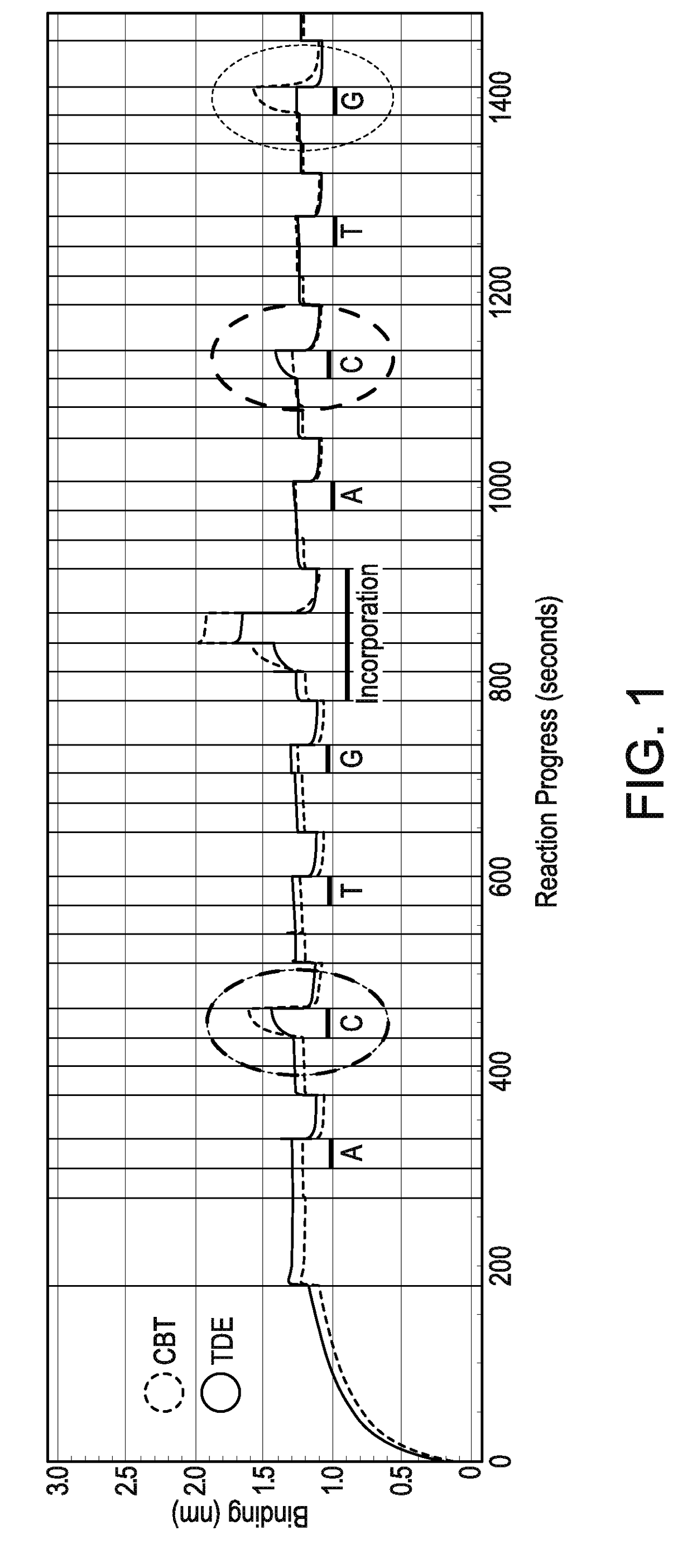Method of nucleic acid sequence determination
a nucleic acid sequence and sequence determination technology, applied in the field of biotechnology, can solve the problem that the dna polymerase used in the method is substantially inability to catalyze the formation of phosphodiester bonds in the presence of magnesium ions
- Summary
- Abstract
- Description
- Claims
- Application Information
AI Technical Summary
Benefits of technology
Problems solved by technology
Method used
Image
Examples
example 1
DNA Sequence Determination Using a Crippled DNA Polymerase and Fluorescent Nucleotides
[0290]A crippled DNA polymerase possessing cognate nucleotide binding and discrimination activities, but not the ability to form phosphodiester bonds first is obtained. A primed template nucleic acid immobilized at a defined position on a solid support in an array format of a flow cell is contacted with a first reaction mixture that includes the crippled polymerase, and dATP labeled with a fluorescent moiety on the gamma phosphate. Fluorescence monitoring indicates no fluorescence signal above background. This indicates that dATP is not the next correct nucleotide. The first reaction mixture within the flow cell is replaced by a second reaction mixture that includes the crippled polymerase, and dGTP labeled with a fluorescent moiety on the gamma phosphate. Fluorescence monitoring indicates substantial fluorescence above background. This indicates that dGTP is the next correct nucleotide. The second...
example 2
DNA Sequence Determination Using a Fluorescently Labeled Crippled DNA Polymerase
[0292]A crippled DNA polymerase possessing cognate nucleotide binding and discrimination activities, but not the ability to form phosphodiester bonds first is obtained. The crippled DNA polymerase is labeled with a fluorescent moiety on the functional group of a surface-accessible cysteine amino acid. A primed template nucleic acid immobilized at a defined position on a solid support in an array format of a flow cell is contacted with a first reaction mixture that includes the fluorescent crippled DNA polymerase, and native dATP. Fluorescence monitoring indicates no fluorescence signal above background. This indicates that dATP is not the next correct nucleotide. The first reaction mixture within the flow cell is replaced by a second reaction mixture that includes the fluorescent crippled polymerase, and native dGTP. Fluorescence monitoring indicates substantial fluorescence above background. This indica...
example 3
Demonstration of Cognate Nucleotide Identification without Incorporation Using a Crippled DNA Polymerase
[0295]A FORTEBIO® (Menlo Park, Calif.) Octet instrument employing biolayer interferometry to measure binding reactions at the surface of a fiber optic tip was used in a multiwell plate format to illustrate the sequencing technique. Primed template nucleic acid molecules biotinylated at the 5′-ends of the template strand were immobilized onto fiber optic tips functionalized with streptavidin (SA) using standard procedures. The primed template nucleic acid molecule in this procedure had CG as the next correct nucleotides downstream of the primer.
[0296]The cycling procedure involved steps for: (1) washing / regenerating sensor tips; (2) forming ternary complexes that included polymerase and cognate nucleotides; and (3) washing with an EDTA solution to strip complexes from the primed template nucleic acid molecule. An incorporation step followed a complete round of binding and examinati...
PUM
| Property | Measurement | Unit |
|---|---|---|
| Concentration | aaaaa | aaaaa |
| Fluorescence | aaaaa | aaaaa |
Abstract
Description
Claims
Application Information
 Login to View More
Login to View More - R&D
- Intellectual Property
- Life Sciences
- Materials
- Tech Scout
- Unparalleled Data Quality
- Higher Quality Content
- 60% Fewer Hallucinations
Browse by: Latest US Patents, China's latest patents, Technical Efficacy Thesaurus, Application Domain, Technology Topic, Popular Technical Reports.
© 2025 PatSnap. All rights reserved.Legal|Privacy policy|Modern Slavery Act Transparency Statement|Sitemap|About US| Contact US: help@patsnap.com

